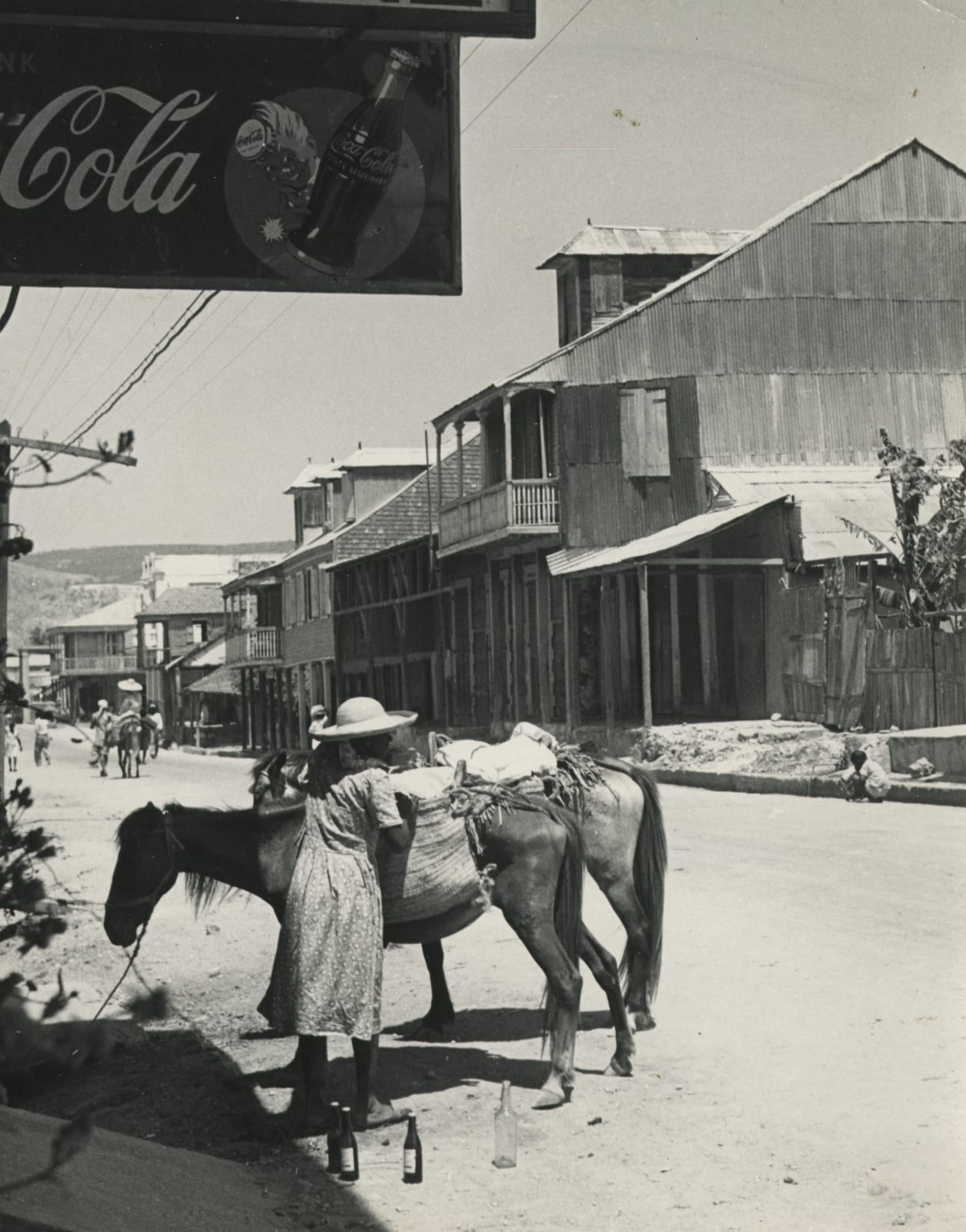Aubrey Janion
Large Group Showing Life in Haiti, Curacao, and the Virgin Islands, 1950s
Silver prints (50)
Most 7 1/2 x 9 inches, a few slightly smaller
Each with photographer's credit stamp and manuscript captions affixed verso.
Each with photographer's credit stamp and manuscript captions affixed verso.
Sold
Further images
-
(View a larger image of thumbnail 1
)
![[Rodney King], Dramatic Aerial Views of the Los Angeles Uprising, 1992](https://artlogic-res.cloudinary.com/w_150,h_150,c_fill,f_auto,fl_lossy,q_auto/artlogicstorage/dollc/images/view/854e1c09a3a652736bafa5b99357e846j/daniel-oliver-aubrey-janion-large-group-showing-life-in-haiti-curacao-and-the-virgin-islands-1950s.jpg)
-
(View a larger image of thumbnail 2
)
![[Rodney King], Dramatic Aerial Views of the Los Angeles Uprising, 1992](https://artlogic-res.cloudinary.com/w_150,h_150,c_fill,f_auto,fl_lossy,q_auto/artlogicstorage/dollc/images/view/a9043d337197ff861b7e2e8614a7f54ej/daniel-oliver-aubrey-janion-large-group-showing-life-in-haiti-curacao-and-the-virgin-islands-1950s.jpg)
-
(View a larger image of thumbnail 3
)
![[Rodney King], Dramatic Aerial Views of the Los Angeles Uprising, 1992](https://artlogic-res.cloudinary.com/w_150,h_150,c_fill,f_auto,fl_lossy,q_auto/artlogicstorage/dollc/images/view/9b597b237ae922e0043c53f251e32bcaj/daniel-oliver-aubrey-janion-large-group-showing-life-in-haiti-curacao-and-the-virgin-islands-1950s.jpg)
-
(View a larger image of thumbnail 4
)
![[Rodney King], Dramatic Aerial Views of the Los Angeles Uprising, 1992](https://artlogic-res.cloudinary.com/w_150,h_150,c_fill,f_auto,fl_lossy,q_auto/artlogicstorage/dollc/images/view/5de04178a301f134a02f2ef0594238ddj/daniel-oliver-aubrey-janion-large-group-showing-life-in-haiti-curacao-and-the-virgin-islands-1950s.jpg)
-
(View a larger image of thumbnail 5
)
![[Rodney King], Dramatic Aerial Views of the Los Angeles Uprising, 1992](https://artlogic-res.cloudinary.com/w_150,h_150,c_fill,f_auto,fl_lossy,q_auto/artlogicstorage/dollc/images/view/2a11e3e7aa8e9f2c66f972110573416dj/daniel-oliver-aubrey-janion-large-group-showing-life-in-haiti-curacao-and-the-virgin-islands-1950s.jpg)
-
(View a larger image of thumbnail 6
)
![[Rodney King], Dramatic Aerial Views of the Los Angeles Uprising, 1992](https://artlogic-res.cloudinary.com/w_150,h_150,c_fill,f_auto,fl_lossy,q_auto/artlogicstorage/dollc/images/view/b6f3e1694c0e7fb037f538df2f243c5bj/daniel-oliver-aubrey-janion-large-group-showing-life-in-haiti-curacao-and-the-virgin-islands-1950s.jpg)
-
(View a larger image of thumbnail 7
)
![[Rodney King], Dramatic Aerial Views of the Los Angeles Uprising, 1992](https://artlogic-res.cloudinary.com/w_150,h_150,c_fill,f_auto,fl_lossy,q_auto/artlogicstorage/dollc/images/view/255337720aef2aa7a9b9497b06abfb60j/daniel-oliver-aubrey-janion-large-group-showing-life-in-haiti-curacao-and-the-virgin-islands-1950s.jpg)
-
(View a larger image of thumbnail 8
)
![[Rodney King], Dramatic Aerial Views of the Los Angeles Uprising, 1992](https://artlogic-res.cloudinary.com/w_150,h_150,c_fill,f_auto,fl_lossy,q_auto/artlogicstorage/dollc/images/view/c0649340abf59678984df32159168959j/daniel-oliver-aubrey-janion-large-group-showing-life-in-haiti-curacao-and-the-virgin-islands-1950s.jpg)
This archive of 50 photographs by photojournalist Aubrey P. Janion provides a comprehensive look at the major cities of Haiti during a short period of relative peace after overthrowing a...
This archive of 50 photographs by photojournalist Aubrey P. Janion provides a comprehensive look at the major cities of Haiti during a short period of relative peace after overthrowing a dictatorship and before the deadly hurricane of 1954. Janion’s photographs reveal the dynamics of early Westernization and the long lasting effects of colonization in cities like Port-Au-Prince and Léogâne, in contrast with more traditional cities like Milot and Ca-Ira. Beautiful landscapes show ornate cathedrals peering out from tropical flora. Men and women wear western clothing topped with a fedora or a woven basket on their heads. The urban life of Port-Au-Prince takes shape in places such as the Cabane Choucoune, the leading nightclub of Haiti where Haitian and international entertainers make appearances, or in the Coca-Cola advertisements tucked away on building walls. The photos in Léogâne, the home of the great Rara festival, show the people celebrating the Easter season in a series of musical street processions. Janion takes particular care to display the beauties of the country as many of the photographs show the breathtaking ruins of Sans-Souci Palace, the residence of King Henry I; and the picturesque coastal town of Ca-Ira.
The collection also features two images taken by Janion of Blackbeard’s Castle Hotel in St. Thomas Port in the Virgin Islands and eight more photographs of the famous Venezuelan floating market in Willemstad, Curacao.
Born in London on April 1, 1894, Aubrey Penderel Janion attended the Royal Military College of Sandhurst and became a Lieutenant in the Dragoon Guards of the British Army. After serving in WWI, Janion lived in Hawaii before returning to Europe to write a book for the Paris Herald under the pen name WIlliam Penderel. He made his way back to the US to work as a photojournalist for publications and magazines for twenty-five years. In the 1970s, he moved back to Maui in Hawaii and became the president of the Maui Historical Society. He published many books throughout his career including his most known title, “The Olowalu Massacre.” He died in Paia, Maui on July 1, 1986.
The collection also features two images taken by Janion of Blackbeard’s Castle Hotel in St. Thomas Port in the Virgin Islands and eight more photographs of the famous Venezuelan floating market in Willemstad, Curacao.
Born in London on April 1, 1894, Aubrey Penderel Janion attended the Royal Military College of Sandhurst and became a Lieutenant in the Dragoon Guards of the British Army. After serving in WWI, Janion lived in Hawaii before returning to Europe to write a book for the Paris Herald under the pen name WIlliam Penderel. He made his way back to the US to work as a photojournalist for publications and magazines for twenty-five years. In the 1970s, he moved back to Maui in Hawaii and became the president of the Maui Historical Society. He published many books throughout his career including his most known title, “The Olowalu Massacre.” He died in Paia, Maui on July 1, 1986.







